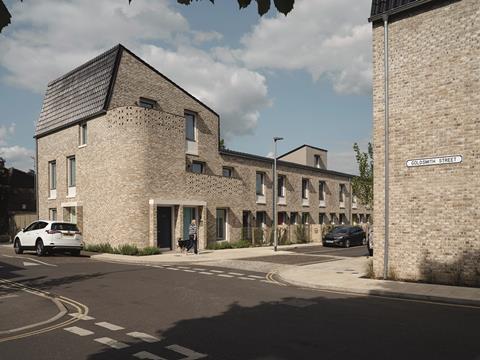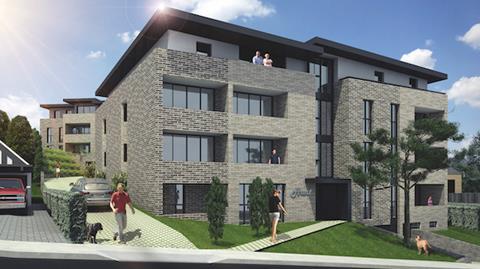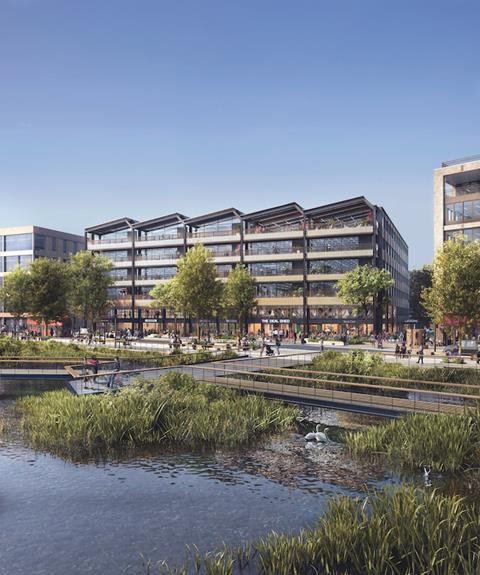To have any chance of getting to net zero carbon by 2050, huge efforts will have to be made in reducing emissions from the built environment. Thomas Lane reports on the industryÔÇÖs response to the challenge

Last week, Boris Johnson announced that the UK will cut its carbon emissions by 68% compared with 1990 levels before 2030. The UK was already committed to reducing carbon emissions to zero by 2050, with an interim target of 53%. In typically ÔÇťwe are better than the EuropeansÔÇŁ, chest-thumping style, the UK target now bests the EU interim target of a 55% cut in emissions by the end of the decade.
Some scientists and green campaigners say that Johnson has not gone far enough, with Imperial College research finding that it was economically feasible to cut emissions by 72% by 2030.
However the targets are sliced, achieving net zero by 2050 is a massive challenge. A baby step in the right direction came in the form of JohnsonÔÇÖs announcement of a 10-point plan for a ÔÇťgreen industrial revolutionÔÇŁ last month. Also billed as a bid to stimulate an economy that has been devastated by the coronavirus pandemic, the plan includes ambitions to reduce emissions from transport and encourage active travel, as well as for the promotion of a hydrogen grid and carbon capture and storage.
This is the biggest challenge of our time, and understanding how to meet net zero targets is now seen as business-critical for construction firms
The point that covers the built environment promises an additional ┬ú1bn towards current initiatives to reduce emissions from existing buildings. Like many of JohnsonÔÇÖs announcements, it was big on promises and light on detail, an example being the ambition to install 600,000 heat pumps a year by 2028 without addressing the matter of how to persuade homeowners to stump up about ┬ú10,000 each to have one installed. It also promised to speed up the introduction of the Future Homes Standard, which will ban fossil fuel appliances in new homes in ÔÇťthe shortest possible timelineÔÇŁ rather than by 2025 as previously billed.
Reducing emissions from the built environment is essential to achieving our overall net zero ambitions. According to the UKGBC, the built environment contributes 42% of the UKÔÇÖs carbon emissions, with the bulk of this coming from operating existing buildings. This is the biggest challenge of our time, and understanding how to meet net zero targets is now seen as business critical for construction firms. For that reason the ║├╔ź¤╚╔˙TV Boardroom has produced an in-depth report that covers everything from definitions and targets around net zero to key considerations for new and existing buildings, as well as insights into how clients are navigating their way through. For more on the report, see below.
What is net zero?
Net zero is a state where greenhouse gases added to the atmosphere balance those that are taken out. . This splits into two equally important areas.
The first part covers the carbon emitted from manufacturing the products and processes used to construct the building and the second the energy used to operate it.
Emissions should be zero or negative, achieved using offsets and onsite or offsite renewable energy.
A whole-life carbon calculation should be done at the design stage to minimise emissions, as investing more carbon at the construction stage may be more than offset by operations emissions savings and vice versa. The assessment should also include the emissions from maintenance and refurbishment and the demolition and disposal of the building at the end of its life.
Existing buildings vs new buildings

It is a well-known fact that 80% of the buildings that will be around in 2050 have already been built, therefore efforts to reduce emissions must primarily focus on existing stock. Reducing emissions from the UKÔÇÖs 29 million homes is particularly challenging because of the costs and disruption of upgrading homes and the lack of incentives for homeowners to do so.
Regulations to control emissions from new buildings have been in place for many years. The Future Homes Standard consultation proposed to ban fossil fuel appliances from 2025, but is now being promised earlier, as soon as 2023, according to a report in The Times, much to the dismay of housebuilders. It promises to reduce carbon emissions from homes by 75%-80% compared with 2013 standards. Proposals for updated regulations to reduce emissions from non-domestic buildings were promised early this year but have yet to materialise.
Once energy use in new buildings has been reduced to a minimum, the idea is this energy will be supplied by a decarbonised grid. The 10-point plan promises a quadrupling of offshore wind power by 2030 and investment in a new generation of small nuclear reactors. Achieving net zero in the built environment depends on how quickly this can be achieved.
Whole-life carbon
This drive towards net zero has prompted a new focus on whole-life carbon in measuring emissions. Whole-life carbon includes the carbon emitted from a buildingÔÇÖs operation and those embodied in the materials and processes used to construct, maintain and refurbish it ÔÇô and to demolish it at the end of its life.
Embodied carbon emissions are currently not regulated, but the first steps towards their inclusion are included in the draft London Plan, which proposes that developers of large schemes should submit a whole-life carbon calculation at planning stage. Embodied carbon regulations will be an important step towards meeting the governmentÔÇÖs 2050 zero carbon target.
The RIBA, the London Energy Transformation Initiative (LETI) and the UK Green ║├╔ź¤╚╔˙TV Council (UKGBC) have introduced targets for 2030 which require the industry to reduce embodied carbon by two-thirds. The UKGBC published a report examining the feasibility of meeting these targets in September. It modelled an office building and an apartment block to see what changes were needed to the design and construction of these buildings to meet the targets and what it would cost.
It found that getting close to the 2030 targets required a switch to an all-timber structure, resulting in the loss of internal space because of the thicker structural elements. It also required that the carbon sequestered in the timber be accounted for in the embodied carbon calculation ÔÇô an assumption that is open to some debate as this carbon is released if the timber is burned or allowed to rot.
The modelling showed that the net zero office would cost between 8% and 17% more than a standard building per square metre of gross internal area, while a residential building would cost an additional 5.3%.
Steps developers are taking
A handful of UK developers are already trialling timber net zero buildings and report that these are substantially more expensive. Eighty per cent of the existing stock needs to be retrofitted and are substantially more expensive than similar buildings with standard construction, because of a shortage of skills and the lack of competition in the supply chain. Such additional costs should fall as low embodied carbon construction becomes the norm.
Some clients are already engaging with the net zero targets. Office and retail developers and landlords are taking action to reduce emissions from their property portfolios because of the environmental and social governance (ESG) policies of corporate occupiers and investors.

Land Securities and British Land are both targeting 2030 for net zero portfolios and have introduced strategies to reduce emissions from existing and new buildings. Developers of large mixed-use schemes being built out over the next 15-20 years need to consider moving towards all-electric infrastructure, particularly as gas boilers are likely to be banned in new homes before 2025.
The public sector has enthusiastically engaged with the net zero target, with a substantial proportion of councils setting a net zero target of 2030. Whether they have the skills or resources to achieve these targets remains to be seen. For many, net zero ambitions are tempered by limited resources and other, more pressing priorities. For example, housing associations are fully occupied with post-Grenfell fire safety works, which are estimated to cost £6bn in London alone.
Government departments have the challenge of limited resources combined with huge, inefficient sprawling estates that are difficult to decarbonise. Healthcare buildings are occupied 24 hours a day all year round, making them particularly energy-intensive as well as difficult to retrofit.
The Department for Education (DfE) is developing a net zero strategy, but implementing this will be difficult as the schools estate consists of buildings of all ages and construction types that are owned and managed by local authorities and academy trusts. Success will depend on engagement by headteachers and local authorities. The DfE has more control over new-build schools as it funds these and has launched a new-build net zero pilot programme called GenZero, which aims to develop a net zero prototype for schools.
The pandemic has impacted net zero ambitions, and the financial squeeze affecting the public sector could slow progress towards net zero. The private sector is less affected, however, because the need to safeguard future property values is a priority.
The lockdown gave some the space to develop net zero strategies, and the unprecedented changes in working practices have encouraged the uptake of digital technologies, the adoption of MMC, and more sustainable approaches to construction. The biggest challenge is retrofitting existing buildings, particularly homes, and raising the awareness and improving the skillset of smaller clients and industry firms.

Net Zero Live: webinar highlights
The energy efficiency challenge
As part of Net Zero Live last month, ║├╔ź¤╚╔˙TV hosted a webinar with an expert panel focusing on the operational carbon footprint of buildings and some of the energy-efficient solutions available.
Simon Wyatt from Cundall is clear about the challenges, saying that to be net zero all sectors of the economy have to increase the use of renewables and reduce the demand on the grid. If all sectors did that equally, it would equate to a 60% reduction in the operational requirements for buildings.
The problem is that other sectors will find it more difficult to hit that target, so buildings might need to go further ÔÇô to a 70% reduction. This means construction professionals need to make whole system changes in how they design buildings, not just tweaks.
Marco Abdallah of Drees and Sommer says that when it comes to new buildings, we already have the technology to achieve net zero targets, but getting there is a matter of collective will.
City Hall in Freiburg, Germany, is in fact an example of a ÔÇťplus energyÔÇŁ building, which Abdallah says produces more clean energy over the year than it needs by combining solar shading, voltaics and a highly insulated facade. Not only does this mean that the buildingÔÇÖs energy demand is below the UKGBC target of 55kWh/m2/yr ÔÇô most buildings are over 200kWh/m┬▓/yr ÔÇô the measures to achieve that pay back, so that money is saved over the full life cycle of the building, compared with a conventional approach.
When it comes to net zero much of the attention has been on new buildings; however, the carbon target for 2050 applies to all buildings ÔÇô and there is a huge need to focus on existing assets in order to reduce emissions. CundallÔÇÖs Wyatt says that buildings need to optimise their performance across all systems. This will take time and every building will have its own unique strategy of interventions to achieve the targets.
Refurbishment and existing buildings
Given that 80% of the buildings that will be around in 2050 exist today, it is unsurprising that the importance of refurbishment and retrofit is central to any discussion around achieving net zero in the built environment. Speaking as part of Net Zero Live discussions on the topic, Richard McWilliams, director of sustainability at Turner & Townsend, said it was imperative the scale of the challenge was not underestimated.
Eighty percent of the existing stock needs to be retrofitted and, to add insult to injury, less than 1% of new-build projects meet the requirements for net zero
Richard McWilliams, Turner & Townsend
ÔÇťReal estate represents 44% of the built environmentÔÇÖs emissions and we really are not doing enough about it,ÔÇŁ he said. ÔÇŁEighty percent of the existing stock needs to be retrofitted and, to add insult to injury, less than 1% of the actual new-build projects meet the requirements for net zero.ÔÇŁ
With the scale of the problem clear, the issue becomes finding solutions, with Kieran Walker, technical director of the Home Builders Federation, saying it is imperative that the industry comes together in this. ÔÇťWe are not going to achieve what we need in this space without a cohesive plan and approach,ÔÇŁ Walker said.
He also said this was particularly important as the solutions ÔÇô such as heat pumps and other net zero technology ÔÇô are ÔÇťnot matureÔÇŁ industries, and so need support and a secure pipeline to develop.
This thought was seconded by David Pierpoint, chief executive of the Retrofit Academy, who said: ÔÇŁWeÔÇÖve got to get the capacity and capability of that supply chain as fast as we possibly can, then government and investors will have more confidence and invest. Industry needs to innovate itself; we canÔÇÖt expect government to do all of this.ÔÇŁ
The discussion also explored how to motivate people to invest in net zero, with Robert Wolstenholme, founder at Trilogy, saying the way to encourage occupiers to want net zero spaces is by showing them the monetary advantage. ÔÇťOf course they donÔÇÖt like paying big services charges, so can we find ways of reducing those costs?ÔÇŁ he asked.
Lucelia Rodrigues, chair in sustainable and resilient cities at the University of Nottingham, agreed that the financial side of things could be a motivator for all ÔÇô even individual homeowners. ÔÇŁEven people in poverty found the top benefit of upgrading was the financial gain,ÔÇŁ she said. But Rodrigues also pointed out that many people do simply want to upgrade their physical assets as they believe it is the right thing to do.
ÔÇťUpgrade your buildings, upgrade your homes, because you will be doing benefit for us all.ÔÇŁ
To view the webinar presentations go to building.co.uk/net-zero-live
ÔÇśThere just needs to be more incentive to retain and refurbishÔÇÖ
Elizabeth Hopkirk talks to Jerry Tate, founder of sustainability specialist Tate Hamer, about enshrining carbon targets in planning policy
Developers must be incentivised to reduce embodied carbon right from the start of projects if the UK is to make significant progress towards its net zero-carbon commitments, a leading architect has said.
Statutory pressure should be imposed at national level through a mechanism such as the National Planning Policy Framework (NPPF) to create clarity and a level playing field, said Jerry Tate, founder of sustainability specialist Tate Harmer.

While strides have been made to reduce buildingsÔÇÖ operational carbon, the focus on embodied carbon is lagging, he said in a talk at Assemble Media GroupÔÇÖs Net Zero Live event. Now was the moment to enshrine targets in law, since ministers are redrafting the planning white paper, he said.
ÔÇťThere needs to be some sort of statutory pressure on embodied energy and itÔÇÖs simply not there yet, but without that weÔÇÖre finding itÔÇÖs hard to demonstrate value for embodied carbon. There just needs to be more incentive to retain and refurbish.ÔÇŁ
Harmer said rules to reduce embodied carbon could be implemented through planning conditions or building regulations. His preference was for it to be embedded in the planning system to force clients to think about it earlier.
ÔÇťWhen people are thinking about knocking a building down, if they knew there was a clearly defined embodied energy target and that they could meet it by not knocking the building down, that would really help,ÔÇŁ he said.
He predicted carbon-reduction performance fees ÔÇô akin to planning performance fees ÔÇô would begin to be incorporated on an ad hoc basis such as in the new London Plan, but that would disadvantage developers in the capital. ÔÇťIt has to be something thatÔÇÖs at NPPF level; it has to be nationwide,ÔÇŁ he said. ÔÇťIÔÇÖm probably making myself unpopular, but it would steer things in the right direction.ÔÇŁ
His remarks echo those made by David Mikhail of Mikhail Riches in his acceptance speech last year when Goldsmith Street, a Passivhaus housing development in Norwich, won the Stirling Prize.Addressing the housing secretary, Robert Jenrick, who was in the audience, Mikhail said: ÔÇťMeasuring embodied carbon has to be the next step. I think itÔÇÖs important the minister is here today.
ÔÇťWhat we would ask for is: we want government to regulate. We need you to set up a level playing field so we are not seen as the so-called crusties in the room.ÔÇŁ
Green revolution or total mayhem?

In theory the government is about to start retrofitting 2,700 homes every day, but we have barely begun to discuss how ÔÇô or even if ÔÇô the work should be carried out, says Julia Park
No doubt I am not the only person to have been cold-called and urged to take advantage of the grant available under the governmentÔÇÖs green homes retrofitting initiative. On both occasions the caller made it sound easy until I explained that our house has an exposed timber frame with brick infill. By the time I had mentioned that the village is in a conservation area and most of the houses are at least 200 years old, they had lost interest. But the calls forced me to confront some realities.
For practical and aesthetic reasons, it feels very unlikely that the insulation needed to bring our home up to scratch could be applied externally, though that is generally preferable in terms of performance. With solid walls, the only alternative is to insulate internally.
I imagine we would need at least 200mm of insulation to make a real difference. Our house is detached. As most rooms have two outside walls, ÔÇťthe shrinkageÔÇŁ would be as painful as the upheaval: the shower room would no longer function and the kitchen would have to be taken out, shortened and put back; we would need to excavate the ground floor to install insulation and that would probably require underpinning; we would have to take down all the ceilings on the top floor to increase the roof insulation and replace the windows and external doors.
At least £80,000 later, I can guarantee that, however hard we had tried, we would be left with gaps, cold bridges and lots of messy bits. And probably still trying to get the local conservation officer to allow us to install an external power pod to charge our electric car.
DonÔÇÖt get me wrong ÔÇô this needs to happen. I am just trying to understand how it might work in the 20 million homes in England that need upgrading. Most will be less challenging than ours, but the majority wonÔÇÖt be easy or cheap. The maximum grant of ┬ú10,000 does not go far when you work through the process; it already feels as though homeowners and landlords would need to make a substantial contribution.
The questions keep coming. Given the climate emergency, how much individual and collective choice should we have? Are we allowed to mind that terraced streets could be changed forever because an owner decides to overclad at random? Should we be lobbying for planning permission to instill some consistency? Should the owners of semi-detached homes have a duty to co-operate? Should someone insist that it is done street by street ÔÇô it ought to be cheaper? And what are the sanctions for not playing ball?
It is concerning, then, that the retrofitting programme is due to be up and running within weeks and without an apparent plan or a monitoring regime. Given that we need to be upgrading 2,700 homes a day from now to 2050, this needs tackling in a much more intelligent, comprehensive and co-ordinated way.

Our housing stock is the oldest in Europe. Based on recent performance, up to 85% of todayÔÇÖs homes will still exist in 2050. How should we weigh the personal trauma and embodied carbon caused by demolition against the operational energy and other advantages of rebuilding for a 200-year life? My guess is that it is probably not worth spending more than ┬ú10,000 on a building that might only last another 25 years, even supposing the owners were able to meet the additional cost. But I have no idea where the tipping point is.
The targeted demolition of tired suburban housing could triple density. Scaled up, that has the potential to avoid more building on greenfield sites and might even release land for food growing, recreation or re-wilding. At what point do those benefits outweigh the release of embodied carbon, and who should decide?
And let us not forget that climate change is only one casualty of our failure to build better housing. Only 9% of existing homes provide even the four basic accessibility elements that make a home ÔÇťvisitableÔÇŁ. Given the cost and disruption of a green retrofit, it would be madness not to address other serious pre-existing shortcomings ÔÇô but who would pay?
A report published by the New Economics Foundation in July ÔÇô A Green Stimulus for Housing: The macroeconomic impacts of a UK whole house retrofit programme ÔÇô calls for a ÔÇťcomprehensive policy approachÔÇŁ, a new suite of regulations and new funding instruments. It advocates a ÔÇťwhole house approachÔÇŁ; explicitly mentioning wrapping-in age-related adaptations and fire safety improvements. It recommends the creation of a national retrofit taskforce and wants local authorities to play a key role.
The authors estimate that every ┬ú1 spent on retrofitting ÔÇťfuel-poor homesÔÇŁ would save 42p in NHS spending, and cites evidence that spending ┬ú10bn on improving all of the ÔÇťpoor housingÔÇŁ in England would save the NHS ┬ú1.4bn a year ÔÇô paying for itself in just over seven years. A no-brainer if it works.
Understandably, it leaves the practicalities to others. The RIBA perhaps? Impressive though it is, rather than tread on the economistsÔÇÖ toes with a list of recommendations to the Treasury, we might have expected the new RIBA report to address some of the more tangible elephants in the room that I have touched on.
Fortunately, the London Energy Transformation Initiative is on the case. After the success of the climate emergency design guide, an even larger group of experts is compiling a set of generic case studies comprising different housing typologies to help everyone understand the principles and best approach to take. No quick-fix vaccine for decarbonisation; just a lot of hard, but vital, work.
Julia Park is head of housing research at Levitt Bernstein and ║├╔ź¤╚╔˙TV DesignÔÇÖs Architect Leader of the Year for 2020




























No comments yet